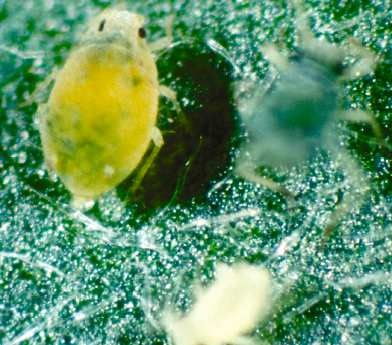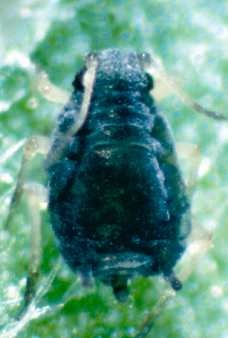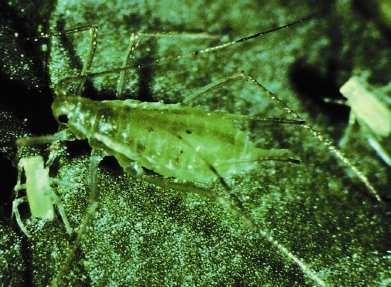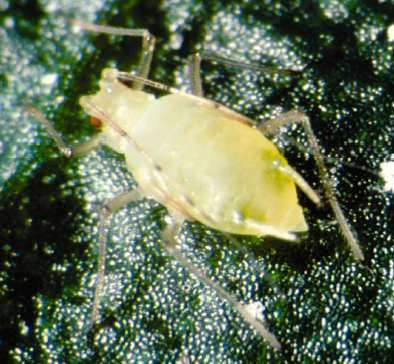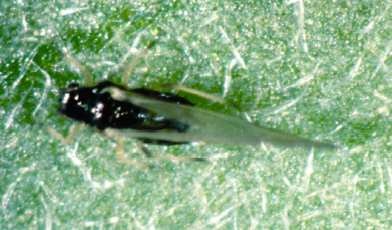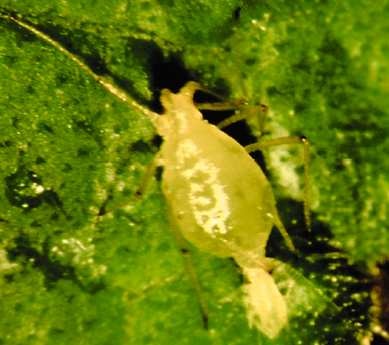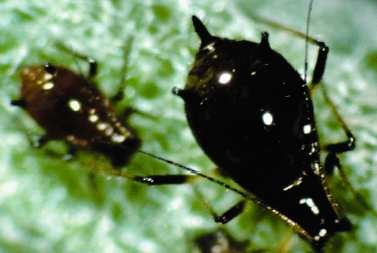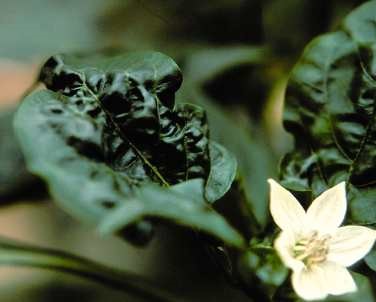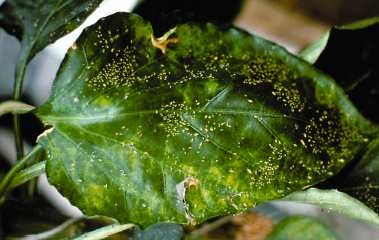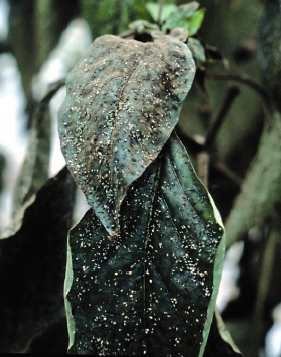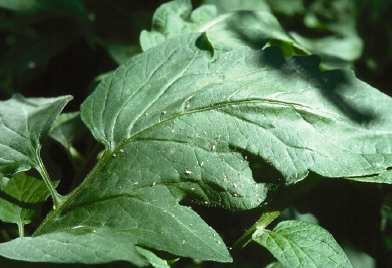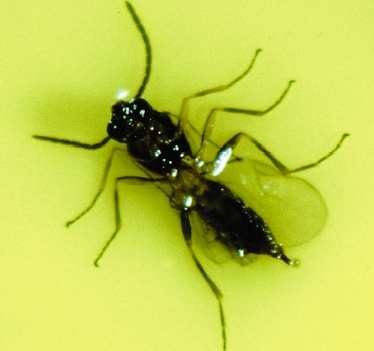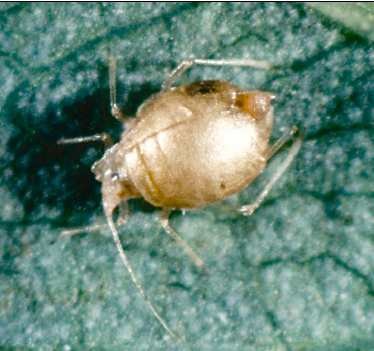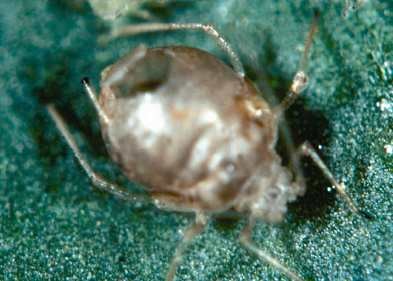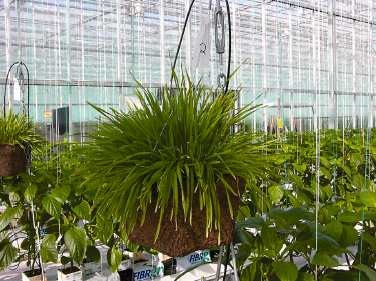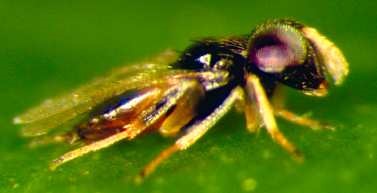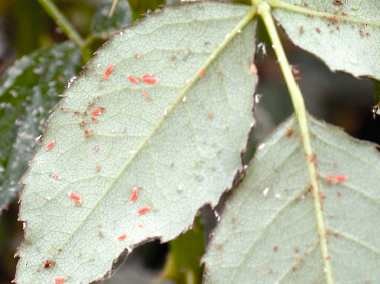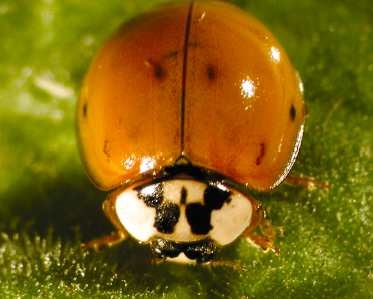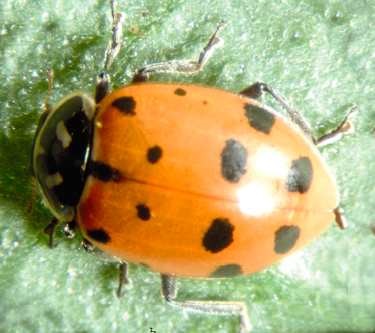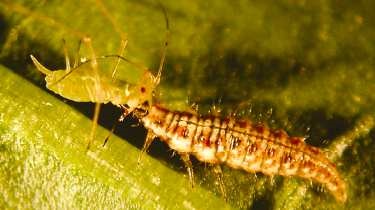Aphids in greenhouse crops
Learn about identification, damage and management strategies for aphids in greenhouse crops.
ISSN 1198-712X, Published August 2006
Introduction
Aphids are small (2–3 mm), soft-bodied insects with long legs and antennae. A pair of tube-like structures called cornicles project from the posterior end. Several species may infest greenhouses, with colour patterns ranging between black, grey, red, yellow and green. The species most commonly found in greenhouse crops are the green peach aphid (Myzus persicae) (Figure 1), the cotton or melon aphid (Aphis gossypii) (Figure 2), the potato aphid (Macrosiphum euphorbiae) (Figure 3) and the foxglove aphid (Aulacorthum solani) (Figure 4).
Adult aphids are predominantly wingless, although winged adults (Figure 5) can develop under conditions of high population density. This adaptation serves as a dispersal mechanism, allowing aphids to move into a greenhouse from outside, or to spread rapidly within a greenhouse.
Description and life history
The aphid life cycle outdoors is quite complicated, at times involving sexual reproduction and egg-laying, while at other times, only females are present, reproduction is asexual and offspring are born live (Figure 6). In the greenhouse however, the life cycle is usually very simple. All individuals are female. They give birth to live young, which in turn can reproduce within 7–10 days. Individual aphids can give birth to 60–100 young (depending on host plants and nutritional status) over a 20-day period. Aphid numbers can rapidly build up to very large populations.
Identification of aphid species is critical to successful control, especially biological control, but also in some cases with chemical control. The green peach aphid and the melon aphid used to be the most common species found in Ontario greenhouses. However, since the late 1990s, the potato aphid and the foxglove aphid have become much more common.
There are several thousand aphid species that have been described worldwide. Positive identification can be very time consuming and complicated and is best left to researchers or extension specialists. Because there are only a few species that are most likely to be found in a greenhouse, there are a number of things growers can look for to help distinguish between them. A hand lens (10x) is needed to see some of these characteristics. If in doubt, consult a specialist in your area for advice.
Colour and general appearance
Be aware that colour on its own is not an accurate way to identify aphids. While it may be useful in combination with other features (see below), do not use colour as the only diagnostic tool. The green peach aphid is commonly a light greenish-yellow, but it can be a darker green or sometimes a pink/rose colour (Figure 1). Melon aphids are a smaller species, and are often a very dark green (in Ontario, growers often refer to them as 'black' aphids), but this too can vary, and it is not uncommon to see 'black' aphids that are green, yellow or mottled (Figure 2). The potato aphid is a large, very active aphid, usually green, but can be variable in colour and often has a darker stripe down the middle of its back (Figure 3). The foxglove aphid is green, often quite shiny and with two darker patches on its abdomen at the base of the cornicles (Figure 4). Occasionally, less common aphids are also seen. Figure 7 shows the chrysanthemum aphid that is shiny and dark brown in colour.
Cornicles
The cornicles are two tubular structures that emerge from the end of the abdomen. On green peach aphids, these are the same colour as the body, slightly flared and darker at the tip. In melon aphid, the cornicles are shorter, and dark throughout their length, regardless of their body colour. In potato aphid, the cornicles are long and thin and may be curved outward at the tips. They are the same colour as the body. The foxglove aphid has cornicles of medium length, darkened at the tips.
Antennae
At the base of the antennae on aphids are two bumps called tubercles. The shape of these tubercles is also used to determine identification; however it is usually necessary to have a microscope to see them clearly.
Damage
Aphids pierce plant tissue with their mouth parts and suck out the sap, causing deformed leaves and flowers (Figure 8a and 8b).
- They excrete a sugary, sticky substance called honeydew, which promotes the development of black, sooty mould fungus on the leaf surface. Sooty mould is not pathogenic on the plant, but in severe infestations, it can interfere with photosynthesis (Figure 9).
- Aphids can transmit plant virus diseases (for example, cucumber mosaic virus).
- In ornamentals, the presence of the aphids themselves, their cast-off skins, honeydew and sooty mould is largely responsible for their pest status. For these reasons, they usually require control long before actual plant damage occurs (Figure 9, Figure 10).
Management strategies
The rapid reproductive rate of aphids and the potential damage that they can cause dictate the need for early detection and timely implementation of management strategies. Integration of several approaches or strategies is often necessary for optimum suppression of aphid populations and avoidance of resistance development. Important strategies for managing aphids are outlined below.
Monitoring for aphids in the greenhouse
Monitoring for aphids involves two different strategies:
- Visual observation — It is important to carry out visual observation of the crop on a regularly scheduled basis for wingless aphids on plants. Look for insects and the small white flakes that are the cast-off skins of aphids as they moult. Initial infestations are usually at isolated points within the greenhouse, but can rapidly spread to other areas if allowed to develop unchecked. Heavier infestations can result in the presence of honeydew on the leaves, giving them a shiny appearance and a sticky feel. Ants are often attracted to the honeydew, and their presence can also suggest an aphid infestation. Different plant species and varieties are more or less attractive to aphids. Use varieties or crops known to be susceptible to aphids as indicators for early detection. This can make monitoring more time-efficient and effective.
- Monitoring aphids using yellow sticky cards — This method is very effective in detecting winged aphids. The presence of winged aphids on sticky cards indicates one of two possibilities:
- There has been movement into the greenhouse of aphids from outside. This often happens in the spring and fall as migrating aphids begin flying in warm weather.
- b. An infestation within the greenhouse has developed to the point where winged individuals are being produced and dispersing to find new host plants (an effective crop inspection program should identify these infestations before they reach this stage).
Biological control
A number of biological control agents are readily available: the parasitic wasps Aphidius spp. and Aphelinus abdominalis, the predatory midge Aphidoletes aphidimyza, and ladybeetles (Hippodamia convergens, Harmonia axyridis) are the most common. Lacewings and praying mantids are more generalist predators and also available for aphid control. Aphidoletes and ladybeetles are usually used to supplement the activity of Aphidius and for reducing aphid populations in 'hot spot' areas.
Aphidius spp.
This parasitic wasp does not enter diapause and is usually more effective during winter, early spring, and fall. During summer, other parasitic wasp species can parasitize Aphidius reducing their impact on aphid populations. Optimum conditions for Aphidius are 18-25°C and 80% RH. Aphidius completes its development from egg to adult in about 10 days at 25°C, and 14 days at 21°C. Three species of Aphidius are commercially available. One is Aphidius matricariae, which can parasitize about 40 aphid species including the green peach aphid. Aphidius matricariae has been largely replaced by Aphidius colemani (Figure 11), which is effective against both the green peach aphid and cotton aphid. Aphidius ervi is a larger species used against potato and foxglove aphids. Aphidius wasps lay their eggs inside the aphid. As the wasp develops, the aphid changes colour and appearance, becoming swollen with a bronze colour and a papery texture (Figure 12). This parasitized aphid is known as a mummy. The new adult wasp emerges from the mummy (Figure 13).
Aphidius species are best used when aphid numbers are very low. To facilitate continuous release of low numbers of these species, many growers use "banker plants" that essentially consist of seedlings of a cereal species (for example, rye) (Figure 14). These seedlings are host to cereal aphid species that do not attack non-cereal crops, and the cereal aphids in turn are hosts or food for the parasitic wasps. Research indicates that for optimum results, evenly distribute banker plants throughout the greenhouse, with a distance of between each banker plant ideally not greater than 40 m.
Aphelinus abdominalis
The main aphids that Aphelinus abdominalis (Figure 15) attacks in the greenhouse are potato and foxglove aphids. This wasp prefers to parasitize the 2nd and 3rd nymphal stages while the 1st and small 2nd nymphal stages are used for host-feeding (i.e. as food by adults). To feed on an aphid, the wasp first pierces the aphid with its stinger or egg-laying body part, and then feeds on the aphid's body fluid through the tiny opening(s).
In contrast to A. colemani, egg laying activity is low during the first few days of this wasp's life. And then by the 4th day after emergence, an adult female can lay 10–15 eggs per day for the rest of its life of 15–27 days. During this time, an adult female may parasitize more than 200 aphids and kill about 40 by host-feeding. Because adults prefer to walk or hop rather than fly over the crop, they tend to remain localized. Studies have shown that dispersal by this wasp is poor in the greenhouse, and that most remain close to their points of release. This means these wasps should be released as close as possible to aphid infestations for best results. Note that aphids parasitized by A. abdominalis appear black while those parasitized by Aphidius species are bronze.
Aphidoletes aphidimyza
Adult Aphidoletes aphidimyza resemble small mosquitoes whose larvae are the predatory stage. Females lay eggs close to aphid colonies so that upon hatching, the orange-coloured larvae have a readily available food source (Figure 16). Eggs usually hatch after 2–3 days, the larval stage lasts 5–7 days after which they drop to the floor to pupate. The pupal stage usually lasts about 8–10 days. Adult A. aphidimyza feed on honeydew and are non-predatory. The larvae can kill between 10–100 aphids in total. A particularly positive characteristic of Aphidoletes is that unlike parasitoids, it causes little disturbance in colonies. Because of its furtive behaviour, it triggers little defensive reaction by aphids. This means aphids attacked by Aphidoletes are less likely to disperse, escape predation, and start new colonies. When aphids are attacked by parasitoids, they defend themselves by kicking and producing alarm pheromones (chemicals used for communication within a species), resulting in their own escape, as well as many other members of their colony.
Under natural daylengths, A. aphidimyza enters reproductive diapause between September and March because the larvae require at least 15.5 hours of light to prevent the pupae from diapausing. However, there is some evidence to suggest that regular preventative releases of Aphidoletes can be made throughout the winter to control aphids. The Aphidoletes adults lay eggs and the larvae feed on aphids, however there is no second generation of midges produced. If lighting can be supplemented, even low light intensities, such as from incandescent bulbs, are sufficient to prevent diapause.
Adults are nocturnal and require a period of darkness for mating and egg-laying. Therefore, continuous lighting from a bright source will prevent reproduction. Likewise, lighting that eliminates dusk can also interrupt mating. It is also important to note that larvae drop to the ground and use grains of sand and possibly soil debris to form cocoons. If the larvae fall on plastic or concrete that is dry and free of debris, mortality of this predator will be high. Repeated or continuous release using banker plants is necessary under such situations to achieve acceptable suppression of aphids.
Ladybeetles
Two species of ladybeetles are commonly produced for control of aphids. Harmonia axyridis (Figure 17), also known as the multi-coloured Asian ladybeetle, is an introduced species that can provide excellent control. However, it has developed a bad reputation because of its establishment and development of huge populations in the outdoor environment, its pest status on crops such as grapes, and its displacement of native ladybird beetle populations. Some biocontrol producers have stopped supplying this species because of its poor public image. The second species, Hippodamia convergens (Figure 18), is a native North American species collected in the wild in California.
Both adult and larval ladybeetles feed on aphids. When daylengths are suitable, ladybeetles must feed on aphids to maintain egg production. Eggs are torpedo-shaped, orange-coloured, laid in circular clusters on the underside of leaves, and hatch in 2–5 days. The larval stage lasts for about three weeks after which they pupate. Adults emerge from pupal cases after 3–5 days. To increase the percentage of ladybeetles remaining in the greenhouse, make releases late in the evening, and sprinkle a sweet liquid (for example, diluted pop), over the beetles. The sweet liquid provides an immediate energy and water source.
Lacewings (Chrysoperla spp.)
Lacewings also feed on a variety of prey including aphids, thrips, spider mites, young caterpillars and moth eggs, mealybugs, scales, and whitefly larvae and pupae. However, they do have a preference for aphids over thrips, and then spider mites. Older larvae (3rd instar) are particularly voracious, (Figure 19) and can eat unhatched eggs, other larvae, and even adults if food is scarce. A larva can consume 300–400 aphids and are usually best suited for high aphid population situations. If there is excess food, more prey will be killed than consumed. Adults, on the other hand, feed only on honeydew, nectar and pollen.
Chemical control
Because aphid populations can build up so rapidly, a regular monitoring program is essential for early detection and control. When detected early (before winged adults are produced), control can often be achieved by spot treatments, or removal of infested plants. There are a number of registered pesticides for control of aphids in both vegetables and ornamental greenhouses, and some of these are compatible with biological control. Please refer to OMAFRA Publication 370, Production Recommendations for Greenhouse Floriculture, Publication 836, Growing Greenhouse Vegetables in Ontario and Publication 835, Crop Protection Guide for Greenhouse Vegetables.
General control strategies
- Remove weeds from within, and immediately outside, the greenhouse. Aphids can develop on many different species of weeds commonly found in the greenhouse, and these can provide an ongoing source of infestation that may never be covered by pesticide sprays.
- Spot treatments or removal of isolated infestations which are detected early, can prevent their spread to the rest of the greenhouse.
- Make use of resistant varieties or crops if possible, or use susceptible varieties as indicators for monitoring or as a check on the effectiveness of control treatments.
- Consider the use of insect screening to eliminate the movement of aphids from outside into the greenhouse. For more information see OMAFRA Factsheet, Screening of greenhouses for insect exclusion.
